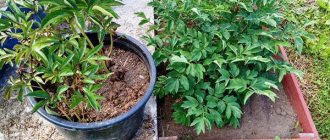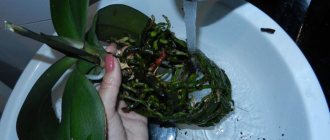You've probably noticed how luxurious your garden looks when peonies bloom and how the room where the vase with peonies stands is transformed. Isn't it beautiful? Believe me, you can grow peonies yourself, and not only in the usual way (dividing the bush), but also from seeds. And it doesn’t matter at all that splitting of varietal characteristics may occur. But you can get a flower at home that no one else has and get involved in breeding work. Of course, this is a long process (peonies grown from seeds will begin to bloom only after 5-6 years), but how interesting it is to wait to see what happens and, as a result, to have a new variety.
Growing tree peony from seeds
Now let's look at how to properly plant tree peony seeds. Typically, professional flower growers are involved in breeding tree peonies from seeds, since this method is much more complicated. In addition, the plant will need 5-6 years for the seed to turn into a flowering bush, while seedlings, depending on their age, can bloom in the first or second year.
In addition, for tree peony seeds to germinate, they require mandatory stratification. In addition, with more or less long-term storage, the seeds completely lose their viability. Thus, growing tree peonies by sowing requires much more patience with no guaranteed results.
The fruits of this plant ripen in September - early October. You can tell that the seeds are ready for collection by looking at the slightly open seed pod. The most viable seeds are large (up to a centimeter in length) seeds that have a shiny, smooth, dark-colored surface. Sowing is carried out after three days of drying. Seeds are placed to a depth of 3 cm in loose, fertile soil until the first frost. It is better if the soil is moist. On the eve of winter, it is recommended to cover the sowing site.
Theoretically, some of the seeds can sprout in the spring, but in most cases, tree peony germinates only in the second or even third year. It is in order to guarantee high germination already in the first spring that it is recommended to subject the seeds to temperature stratification. For this purpose, in the fall, the seeds are buried not in open ground, but in a pot or box with soil. After the pot/box of seeds has overwintered outside, it should be taken indoors in March and kept at room temperature. By following these steps, you can guarantee a fairly high germination rate even in the first spring.
An alternative way to increase the germination of seeds is to collect them immature and place them in damp sand or peat for 10-12 weeks at room temperature. After this, the seeds should be placed in the refrigerator or basement so that they remain at a temperature of 5-8 degrees for about 3 months. In May, such seeds can be planted in open ground at a depth of up to 5 cm. The seedlings should hatch before autumn and will grow very slowly. They should be watered very sparingly, and 3-4 weeks after planting they can be fed with liquid fertilizers. The soil around the shoots is mulched, and for the winter the plants need to be thoroughly covered with peat or dry leaves. You can learn more about how to properly plant a tree peony in the spring from a special video.
Seasonal propagation: what is best and what methods are suitable
Each peony propagation method has a specific time of year.
If you propagate the bush correctly, after a few years you will be able to observe lush flowering.
Spring
It is better to use the root division method. This is done at the end of April - beginning of May.
In March, after the thaw, you can use the method of aerial cuttings.
Before propagating peonies in the spring, you should make sure that there will be no return frosts.
Summer
At the end of August, you can start propagating the plant by dividing the bush.
Autumn
Until September 15, it is allowed to use any breeding method. Planting in open ground is done before the onset of frost.
Any gardener, knowing how to grow peonies, can turn their garden beds into a blooming miracle of beautiful lush flowers. There are many simple breeding methods; everyone chooses their own way to propagate peonies. The exception is the seed method; it is used only by experienced gardeners for selection purposes.
Further care of plants
Caring for a tree peony is simple; even a less experienced gardener can handle it:
- Watering. Rare, but plentiful - 6–10 liters of water per plant once every two weeks. In hot weather, the interval is reduced to 5–8 days. From the beginning of August, the norm is gradually reduced, and by October they stop watering the peony altogether. After each watering, the soil is loosened to a depth of 4–5 cm, the diameter of the tree trunk circle is 0.5 m. Renew the layer of mulch as necessary - it does not allow moisture to quickly evaporate and prevents weeds from growing.
- Feeding. 4 times per season is enough. Every time before fertilizing, abundant watering is required. At the beginning of the active growing season - 40–50 g of nitrogen fertilizer (urea, ammonium sulfate). During the formation of buds and about a week after the beginning of flowering - complex feeding for ornamental flowering plants. A month after flowering - 15–20 g of potassium and phosphorus fertilizers or a glass of wood ash and half the amount of dolomite flour.
- Trimming. It is carried out in the spring, before active growth begins. Please note that buds form on last year's shoots. All dried and dead stems are cut off, shoots older than 5 years are shortened to 15–20 cm. When the bush fades, the stems that had buds are cut to the upper axillary bud. Once every 20 years, rejuvenating pruning is recommended - all stems are cut off almost at soil level, leaving “stumps” 3–5 cm high.
- Shelter for the winter. The plant is afraid not so much of frost as of early thaws and subsequent cold weather. In October, the stems are tied, the trunk circle is cleared of plant debris and mulched with a layer of humus about 10 cm. On top, if dimensions allow, a bag is put on or a “hut” is built (a frame of poles covered with burlap or covering material). The bush under cover is covered with fallen leaves, spruce branches, pieces of bark, and shavings.
Reproduction methods
There are several known methods of propagating shrubs. Gardeners mainly use vegetative methods:
- dividing the rhizome;
- cuttings;
- layering;
- vaccination.
Rhizome division and cuttings
Three or five year old plants with strong branches are suitable for this procedure. This event is held in late summer or early autumn. The bush is carefully dug up, cleared of soil and washed. The branches are all shortened, leaving 10-15 cm, and the workpiece is put in the shade so that the root system dries out. Then the plant is divided into several seedlings with 2-3 buds. The cut areas are treated with charcoal and fungicide. Next, the seedlings are planted in a permanent place in the garden plot.
Propagation of violets at home by leaves and stepsons
Cuttings are carried out during the summer season. To do this, gardeners choose a plant with slightly woody shoots and pronounced nodes. Cut blanks 10-15 cm long and with 2-3 buds, and the lower cut is made obliquely. The cuttings are planted in a container with fertile soil. Each seedling is covered with a cut plastic bottle. Strong cuttings can be planted in a greenhouse until next year. With this method, the plant begins to bloom only in the fifth year.
Reproduction by layering and grafting
Before flowering begins, in the spring, they begin propagation by layering. To do this, make an incision on a long branch, treat it with a root growth stimulator and press it to the ground. First dig a shallow trench. The cuttings are fixed with wire and sprinkled with a 15 cm layer of soil. When the cuttings take root, they are cut off and planted in a permanent place.
To propagate a plant by grafting, you need to put in a lot of effort. Why do gardeners rarely use this method? As a rootstock, blanks from the roots of herbaceous peonies 15 cm in length are used. As a scion, a cutting is prepared from a one-year-old shoot with two buds. A wedge-shaped cut is made on part of the root, and the bottom of the scion is sharpened so that it fits perfectly into the cut. Then they are connected, wrapped in polyethylene and coated with varnish. The joint is placed in a container with damp sawdust until it grows together.
How to propagate peony by vertical layering
When to replant peonies in spring, summer and autumn
In order to propagate a peony in this way, the buds located underground are exposed, and the roots are covered with a bottomless box, its height should be 30-40 cm. It is filled with a mixture consisting of soil (3 parts), peat (1 part) and sand (1 tsp), layer thickness should be about 8-10 cm.
Fresh soil is added once a week until the layer is level with the edge of the box. On the 20th of September, the earthen mixture should be removed and the stems cut off. Shoots with formed buds are planted on the site.
Suitable varieties
Reproduction by vertical layering is used only for milky-flowering peony varieties, for example: Rasberry Ice, Falcon, Red Queen, Jubilee, Monsieur Dupont.
Milky-flowering peony variety Anima
Peonies after flowering
After flowering, the following procedures must be carried out.
Transfer
Transplantation is carried out in August-September. The plant tolerates this procedure painfully. Some branches dry out, but there is no need to panic about this. They are cut off, and in April young buds appear, producing new shoots.
Dry, diseased roots are removed from the dug plant. The sections are treated with activated carbon.
Trimming
In September, the upper shoots with seeds and peduncles are removed to the first bud.
The main pruning is carried out in March-April after the buds awaken. Dead, dried branches are cut off at the root. Strong ones - up to the first bud, and weak ones - up to 10 cm from the soil surface.
Preparing for winter
When the first frosts appear, the shortened shoots are carefully tied loosely with wire or twine and protected from snow drifts with spruce branches, burlap, and lutrasil.
Reliable shelter from the cold
Rules for caring for tree peonies
Watering plants
Tree peony does not need frequent irrigation. You can water it 1-2 times a month depending on weather conditions. The amount of water per watering is approximately 6-7 liters. After irrigation, you should slightly loosen the soil near the bush, while simultaneously removing sprouted weeds. As a rule, tree peonies are watered in the first months of summer, and moisture is stopped in August.
Fertilizing flowers
The first three years of life the plant needs foliar feeding. To do this, 40 g of urea and mineral fertilizers are diluted in 10 liters of water, and then the bush is sprayed after watering.
Peonies over three years old are fertilized three times a year:
- The plant is fed for the first time in early spring, at a time when the bush produces young shoots. Nitrophoska is used as a fertilizer in the amount of 100 g per 1 bush.
- During the period of swelling of the buds, the time comes for the second feeding. It is also carried out with nitrophoska, the amount of fertilizer does not change.
- When the peonies fade, they can be fertilized a third time. For this purpose, use 30 g of superphosphate for each bush.
Bone meal, ash or humus is considered a good fertilizer for tree peonies. Acidic substances and nitrogen fertilizers are not recommended.
Tree peony, photo:
Sheltering peonies for the winter
Despite the fact that the tree peony is considered a frost-resistant crop, in particularly unfavorable climatic conditions the plant needs protection. Preparations for winter should begin in October. At the end of the month, the shoots of the plant are carefully tied up, and the soil near the trunk is mulched with spruce branches or peat. With the arrival of the first frost, the bush must be covered. For this, bags or spruce spruce branches are used.
With the onset of spring, when the buds swell on the shoots, the bushes are freed from shelter. Broken branches are removed, and healthy ones are shortened by one third. If these conditions are met, the flowers of the tree peony will be large and beautiful, and the plant itself will be strong and healthy.
Disease and pest control
This is not to say that tree peonies get sick too often, but they are still susceptible to some fungal diseases. The most common disease is gray mold. It occurs if the bush grows in an overly shaded place where excessive amounts of moisture stagnate in the soil. The development of gray rot is also facilitated by an excess of nitrogen in the soil. If you notice a similar disease on your flowers, cut off the affected stems from the bush and burn them. Then prepare a solution of potassium permanganate at the rate of 3 g of the substance per 10 liters of water, or use a 0.7% solution of copper sulfate. Spray healthy stems with the prepared liquid.
The roots of old bushes are often affected by gray rot. If a similar problem occurs, cut off the diseased areas, treat the cut areas with a 1% solution of copper sulfate, and then sprinkle with crushed charcoal.
Brown spots may sometimes appear on tree peonies. In this case, the affected leaves and stems should also be cut off and burned, and the bushes should be treated with 1% Bordeaux mixture.
Reproduction by dividing the bush
When choosing this method, you need to know when to divide the peonies. The procedure is carried out in the fall. The root system is carefully removed from the ground, trying not to damage it, and washed from the soil. The bushes are placed in the shade for 5-6 hours.
How to propagate gooseberries in spring, summer and autumn
Before dividing a peony, you need to prepare a sharp tool, such as a knife. With its help, the roots are cut into sections, each of which has 3-5 buds. They are examined, broken roots are cut off, disinfected with fungicide, and sprinkled with charcoal. Leave in the shade for a day. Then they are planted in the ground, having moistened it in advance.
Note! In this way, it is allowed to grow bushes that have reached 5 years of age.
Peculiarities
Tree peonies are deciduous shrubs that often grow up to 1.5-2 meters. The plants are characterized by erect, pale brown stems that grow thicker and sturdier every year.
The feathery leaves have an openwork shape and look very unusual. The flowers are located at the ends of the shoots and reach a diameter of 12-20 cm. They come in double, semi-double and simple types and have a very wide color palette. The color of the flowers can be very different, ranging from bright white to soft green, blue and purple hues.
Moreover, among the huge variety of varieties there are also very interesting two-color specimens. The petals of such flowers have a gradient, when one shade smoothly transitions into another. A characteristic feature of tree peonies is the increase in the number of flowers over time. As a result, an adult bush is a bright flowering ball, which often becomes the main decoration of a summer cottage.
At the same time, 70 flowers can be present on one bush, despite the fact that the flowering phase of each of them lasts from 8 to 10 days. Due to the large volume of the bush, it is recommended to plant peony separately from other garden species or at some distance from them.
Plant varieties
Tree peony (Paeonia suffruticosa) is a spreading, branched shrub that can grow up to one and a half meters in height. The leaves of the plant are bright green and feathery. The flowers are large and fragrant.
Their color can be very diverse, like the climbing varieties of roses described earlier, ranging from all shades of pink, red and ending with yellow-orange. Flowering continues for 1-2 weeks, but even after the flowers fade, the bush does not lose its decorativeness and attractiveness, thanks to the unusual shape of the leaves.
There are more than five thousand varieties of tree peony in the world, most of which are Chinese. All of them are divided into three garden groups :
- Chinese-European peonies with double flowers;
- Japanese - simple and semi-double;
- hybrid varieties.
The most popular varieties of yellow peony: Demeter, Golden Pattern, Alhambra, Keneri. Among the red and pink: Vesuvius, Gauguin, Ariadne, Icarus, Guphaestus, Breath of Love, Raphael, Misery. White peonies: Pearl Wind, Mrs. Shirley Fry, Renkaku, etc. American winter-hardy varieties are also popular: Garden Treasure, Bartzella, Prairie Garm .
No less famous are domestic plant varieties: Masquerade, Pechorin, Dreams, Maria, Marianna, Irina, Peter the Great, Girlfriend's Blush, Moscow Evenings .
Variety Moscow evenings
Such a wide variety of tree king varieties is mainly due to the variety of color shades. The most common is the Rock peony with simple flowers in soft pink or white shades.
A characteristic feature of this variety is the presence of a bright fuchsia-colored spot inside the flower. Such peonies are quite common. And it’s not surprising, because it doesn’t require special care, but its crazy flowering following the riot of tulips is simply stunning.
If you plant bushes of white and bright crimson peony next to each other, then in a year or two, to your amazement, you will see that the white flowers will turn into pale pink. The conclusion is not difficult to draw: if you want to keep a peony flower white, be sure to plant it away from pink-red peonies.
In addition, this simple variety has good winter hardiness. The oldest bush has been living on the site for more than 10 years; it is not covered with anything for the winter.
Practice has shown that peony is not afraid of 20-25 degree frosts. Unless they are fertilized, like roses, which we already talked about feeding in the fall https://2gazon.ru/ozelenenie/cvety/rozy/uhod-r/udobreniya-i-podkormka-r/p-osenyu.html. Designers also prefer yellow varieties (Delaveya and Lutea), in which not one, but several flowers bloom on the shoot.
Taxonomy
- Paeonia suffruticosa subsp. suffruticosasyn. Paeonia arborea
Donn, 1804;
Paeonia suffruticosa
var.
purpurea
Andrews, 1807;
Paeonia mutan
Sims, 1808;
Paeonia yunnanensis
Fang in Acta, 1958) - flowers are always double, different colors. Currently known only in cultivation, it has been cultivated for more than 2000 years, and has hundreds of varieties. - Paeonia suffruticosa subsp. yinpingmudan DYHong et al., 1998 - flowers are pure white and solitary, the filaments are purple-red and the floral disc is red-violet. The leaf shape is very similar to the subspecies suffruticosa
, but differs markedly from
Paeonia jishanensis
.
According to The Plant List it is a synonym of Paeonia ostii
T.Hong & JXZhang. - Paeonia suffruticosa subsp. spontanea (Render) SGHaw et LA Lauener (syn. Paeonia spontanea
,
Paeonia jishanensis
).
According to The Plant List it is a synonym of Paeonia jishanensis
T.Hong & WZZhao. - Paeonia suffruticosa var. papaveracea (Andrews) Kerner (syn. Paeonia moutan var. papaveracea (Andrews) DC.)
What does a tree peony look like?
Adult peonies have a hemispherical shape; with good care, they reach a height of one and a half to two meters in a warm climate zone; in Russia they do not exceed one and a half meters. Their flowers are double, semi-double, simple, spherical in shape. The best tree peonies are able to delight the gardener with a huge number of buds with a diameter of up to 22 cm. It is not uncommon for a perennial bush to open up to 100 flowers in a season, breaking off the green stems under their gigantic weight.
The tree peony differs significantly from small herbaceous forms; its care and cultivation have nuances associated with the peculiar structure of the vegetative organs and the characteristics of the life cycle. It has powerful, thick, erect stems that do not die off in winter. Lignified growth normally tolerates frost, so peonies of this type, like roses, are classified as full-fledged shrubs. The dark purple foliage is original and beautiful; after flowering ends, it looks luxurious and attractive in the garden.
When does tree peony bloom?
In many ways, the beginning of flowering depends on the climate and variety. In the Moscow region and northern regions it falls in June and the first days of July, and in the southern regions the buds bloom by the end of May. In the question of how long a tree peony blooms, the weather plays a huge role. On average, this happens up to two weeks, but in cool years the wonderful period can last several days longer.
Tree peony - no worse than a rose
This shrub resembles a tree, its structure allows it to delight its owners with lush flowers for decades, and today there are enough varieties to choose from. Knowing all the rules of care, you can grow a real beauty, not inferior in beauty to a rose.
General information
- Japan and China are considered the birthplace of the tree peony. However, today there are practically no wild thickets of this plant left. Growing under natural conditions can only be found in the south of Tibet or southwest China at an altitude of 2400 m.
- The bush has differences compared to herbaceous plants: its height reaches one and a half meters with good care. There are specimens up to 2.5 m tall. The circumference of the plant is also quite large - approximately 1.5 - 1.7 m.
- The stems are woody, dense and strong, becoming thicker every year, in some the stem diameter reaches almost 10 cm.
- The special charm and pride of the tree peony are its flowers, their circumference is up to 25 cm. The structure can be double, resembling a rose, semi-double or simple. Depending on the variety, the color range is very diverse: bright pink, white, delicate shades of lilac, fuchsia, blue and even green.
- The flowering period for this peony begins only in the 4th - 6th year of life; it blooms several weeks earlier than the bush peony, and the flowering itself lasts 14 - 20 days. At the same time, dark emerald leaves complement the beautiful flowers with lacy greenery.
The difference between tree peonies and ordinary peonies in preparation for cold weather: in bush peonies the aboveground part dies off, and in tree peonies the foliage falls off.
Popular varieties
Let's name a few of the most famous varieties that can be planted in the Moscow region. All of them are very impressive and are used in landscape design to decorate the garden area. Peonies of this type are divided into 3 main groups:
- Chinese;
- bred varieties based on those imported from China;
- hybrids.
The work of breeders does not stop to this day. Peonies were first brought from China to Europe, they also grow in Japan, and lastly they appeared in America. They became known in Russia only in the 18th century, and firmly took a leading position in floriculture. The following varieties have become widespread in the Moscow region.
- Green beans;
- Blue Moon;
- Flight of the Swallow;
- August;
- Vesuvius;
- Spring Waltz;
- Torch;
- Coral;
- Kuindzhi and many others.
What is the difference between self-rooted and grafted peonies?
Dividing into 2 groups allows you to get flowering much earlier. Self-rooted plants live in one place for many years (there are specimens that are 400 years old). But their annual growth is very small, and the flowering period begins no earlier than 4-6 years of age.
They are very well adapted for winter in the middle zone and are easily propagated by root division. Quite resilient. Their roots are represented by elongated light processes 6 - 9 mm thick.
Grafted tree peonies cannot be propagated by dividing the rhizome, but must be planted immediately in a permanent place, since replanting is extremely difficult to tolerate. The advantage is flowering for 1 - 3 years of life. They grow quickly (20 - 40 cm per season). These peonies have a rhizome similar to that of a regular peony, thicker and cylindrical in shape, 3-5 cm thick.
Experienced flower growers advise planting 2 types of such peonies: while the rooted one slowly develops and grows, the grafted one already decorates with its beautiful flowering.
Hello, dear readers!
Peonies are noble flowers that bring good luck, one of the most attractive in the garden.
It is not for nothing that the ancient Greeks were actively involved in the propagation of peonies, considering these beautiful long-livers (the flowers bloom profusely and magnificently for many decades) as powerful amulets against evil spells, protectors from adversity and misfortune.
The kings of the garden plot begin to smell fragrant in the last month of spring and delight us with their lush flowering until mid-summer.
There is never too much beauty! How to properly propagate exquisite flowers?
Seedlings of these wonderful flowers are quite expensive.
Therefore, if we want to plant more bushes of this plant in our garden, let’s master the propagation of peonies ourselves.
The topic of our article today will be the propagation of peonies in several main ways.
It's time to deal with this interesting and important issue.
How to plant a tree peony?
It is advisable to find a well-lit area for a new bush, where it can bloom for a couple of decades without problems. Loose, alkaline soil with good drainage is suitable. Planting a tree peony in the spring after the shoots have begun to grow is risky and undesirable; the optimal planting period is from the second half of August to the last ten days of October. If for various reasons the seedling came to you in late autumn before severe frosts, then it is placed in a container for the winter at a temperature of 5-10°C. We plant the peony immediately after the snow cover melts.
The most important condition is the soil in which you plant the tree peony; it is advisable to care for and grow the flower in slightly alkaline soil, improved with sand, organic matter and mineral components. Prepare a cone-shaped hole up to 70 cm deep, lay out drainage from gravel or broken brick 20-30 cm thick at the bottom. If the soil is acidic, then add bulk lime to it up to 30 g.
Planting peonies
How to plant peonies
Growing peonies will not require a lot of time or excessive effort from you.
The most important thing is to choose the right area for peonies, because they will grow there for many years. The root system of adult plants reaches a depth of 70-90 cm, so replanting a bush that has reached 4-5 years of age is not an easy task.
Peonies prefer to grow in well-lit areas; sunlight for 5-6 hours in the morning is highly desirable. But peonies are afraid of drafts, so it would be nice if they were protected by tall bushes or trees.
Do not plant peonies in low areas: the rhizomes can rot from stagnant water.
In the photo: Growing peonies in a flower bed
As for the choice of soil, loam with an acidity of 6-6.6 pH is best suited for peonies. If the soil is too clayey, you will need to add humus, sand and peat. In sandy - peat, clay and humus. Sand, wood ash and organic matter are added to peat soils.
Planting peonies in autumn
Peonies are planted and replanted in late August - early September. A week before planting peonies, they dig holes measuring 60x60x60 cm at a distance of 70-100 m from each other; a drainage layer of 20-25 cm of coarse sand, broken brick or crushed stone must be laid at the bottom of the holes. Then a layer of top dressing consisting of compost, humus, 100 g of lime, 200 g of superphosphate, 100 g of potassium sulfate, 300 g of wood ash is poured in a layer of 20-30 cm. Then the holes are filled to the top with earth mixed with compost. In a week, by the time the peonies are planted, the soil in the hole will have subsided, which will make it possible to place the peony rhizome in the hole, sprinkle it with garden soil and lightly compact the soil.
Keep in mind that peonies do not tolerate deep planting: the result will be a dense green bush without flowers.
If you want to wait for lush flowering from peonies, deepen the rhizome so that the upper bud is no deeper underground than 3-4 cm. In addition, in the first year after planting or transplanting, peonies do not bloom and look lethargic. It happens that peonies will not bloom the next year, but this is not a problem if the bush looks healthy - it’s just that the peony bush has not yet reached maturity.
In the photo: Peony bud
Planting peonies in spring
Actually, peonies are not planted in the spring. But it happens that in the spring you received the planting material you dreamed of... and what to do? In this case, experts suggest planting peonies in a 2-3-liter pot and keeping them in a cool, dark room - a basement or cellar - until planting them in the ground, keeping the soil moist. To do this, you need to place snow or pieces of ice on top of the soil, which, when melted, will moisten the soil in the pot. At the end of April or May, the peony is taken out into the garden and buried in the ground directly with the pot, where it will remain until the autumn transplant into a prepared hole, carried out by transshipment, that is, together with the earthen lump in which the rhizome was located.
Varieties of tree peonies
The plant has about five hundred species of varieties. They are divided into main groups, each of which has its own characteristics. Types of peonies:
- Japanese look. Distinctive features of this species are semi-double and smooth buds. Light airy flowers are securely attached to the stem, do not hang down, but hover above the bush. The plant has a decorative appearance.
- Sino-European species. Heavy terry buds often hang down, unable to support their own weight. Flowers have a variety of colors.
- Hybrid varieties. Thanks to their yellow color, the flowers are especially popular among gardeners. This color was achieved by crossing yellow peonies with shrub plants.
- Ito hybrids. A spreading plant reaching up to 1 meter in height. Includes some appearances from tree and herbaceous peony.
Tree peony planting site
According to descriptions, the tree peony prefers places that are intensively illuminated by the sun in the morning and evening, and fall into the shade during the day; scorching midday rays shorten the flowering time. The plant does not tolerate gusts of wind well and cannot withstand proximity to other shrubs, trees, and buildings.
Choose a moderately shaded area in the east of the garden. Avoid planting in lowlands and areas where groundwater accumulates. Stormwater and spring snow can harm the plant. The ideal place for planting is a hill with equipped drainage ditches.
Plant bushes in increments of 1.2 m. The distance between peonies and other large shrubs is at least 2 m, otherwise the flowers will suffer from poor soil. The same distance should separate the peony and buildings, since they heat up in the summer and create an extreme background in their own way. There must be at least 3 m to the trees, otherwise the shadow will not allow it to bloom.
The best varieties of burgundy, yellow and pink tree peonies
The variety of varieties can surprise and confuse you. Before purchasing, it is advisable to familiarize yourself with the main varieties so that you know exactly what you want.
16 most popular indoor plantsPhysalis: description of species and varieties, technology for growing from seeds Spruce in landscape design: the best ornamental varieties and cultivation featuresKalanchoe: description of species and features of care at home
August
A truly luxurious variety, it looks royal: with magnificent snow-white flowers (from 13 to 15 pieces), in the middle of which it’s as if a light pinkish spot was painted with watercolors. Reaches 1.3 m. Winter-hardy flower.
Anastasia Sosnovits
Peony with not too large flowers (11-15 cm). The white petals with a purple spot in the middle are not double, but slightly wavy at the edges.
Anastasia Sosnovits
Academician Sadovnichy
Medium sized peony. The yellow flowers, slightly dense and not too bright, open into a beautiful bud revealing a purple core with stamens.
Vladimir Novikov
A variety of rich shade, thick burgundy with a beetroot tone. The shrub is tall, reaches 1.5 m in length. The stamens are crimson, with yellow caps.
It is distinguished by purple-burgundy, large and double inflorescences.
Vladimir Novikov
Irina
Semi-double leaves of pink color: soft salmon at the edges, and in the middle they acquire a brighter shade of rich function. One of the tallest representatives of peonies, grows up to 1.7 m.
Hoffman
Coral
A very unusual and popular variety. It has a unique coral pink color. Numerous leaves tightly fit the core with purple-red stamens.
Maria
Semi-double buds with small pink spots in the middle. Medium-sized bush with light green leaves.
Maria
Smolin
One of the largest varieties. The flowers reach 25 cm in diameter. Their color is milky pink with a spot of bright purple.
Torch
The most memorable peony. There is a real splash of color here - coral, yellow, pink-orange, light peach tones. The beautiful and unique “Torch” enjoys well-deserved popularity.
Seeds
You can grow your own tree peony from seeds. Propagation by seeds is not only an interesting and fascinating process - a plant obtained in this way will have increased immunity to adverse environmental influences, and will bloom only 1-2 years later than specimens obtained by other methods of propagation.
For sowing tree peony, it is best to use freshly harvested seeds. Sown in loose and moist soil, they give good germination and bloom in the 4th-5th year.
After lying for several months or years, tree peony seeds require additional processing and can only germinate in the 2-3rd year.
Tree peony seeds, photo by Alice Lazuta
Before stratification, it is advisable to carry out scarification, so the peel of the tree peony seeds is carefully filed or scratched, and to prevent the seeds from being lost, it is better to do this procedure over a deep container. After this, sowing the seeds in a container with moistened sand, a two-stage stratification is carried out
The first stage is a warm period, before the roots appear, at variable temperatures during the day: 18°C (4 hours) + 30°C (6 hours), it is more convenient to carry out by placing a container with seeds in another - larger in volume, with a cover with an incandescent lamp and turn it on for the required time. The second stage is the cold period. Having pinched the tip of the root, the sprouted seeds of the tree peony are sown in a container with garden soil or a mixture of peat and river sand (1:1) so that the seeds are sprinkled with soil no more than 0.5 cm. and leave at a temperature of 5-10 ° C and a humidity of no more than 10% until a leaf appears. In the spring, after the threat of return frosts has passed, the crops can be taken outside, to a shaded, warm place, and after the leaves have finally unfolded, the seedlings are transplanted into separate pots and at the end of summer or early autumn - transplanted into open ground, to a permanent place , at a distance of 60-70cm. apart from each other
After this, sowing the seeds in a container with moistened sand, two-stage stratification is carried out. The first stage is a warm period, before the roots appear, at variable temperatures during the day: 18°C (4 hours) + 30°C (6 hours), it is more convenient to carry out by placing a container with seeds in another - larger in volume, with a cover with an incandescent lamp and turn it on for the required time. The second stage is the cold period. Having pinched the tip of the root, the sprouted seeds of the tree peony are sown in a container with garden soil or a mixture of peat and river sand (1:1) so that the seeds are sprinkled with soil no more than 0.5 cm. and leave at a temperature of 5-10 ° C and a humidity of no more than 10% until a leaf appears. In the spring, after the threat of return frosts has passed, the crops can be taken outside, to a shaded, warm place, and after the leaves have finally unfolded, the seedlings are transplanted into separate pots and at the end of summer or early autumn - transplanted into open ground, to a permanent place , at a distance of 60-70cm. from each other.
2012 - 2014, Planting a Garden. All rights reserved.
How do peonies reproduce?
These lush homemade flowers are easy to propagate. There are several ways to do this.
- Dividing the bush. This method is good because when the bush is propagated, all the characteristics of the variety are preserved. But it can only be used for adult bushes.
- Stem cuttings. The method is not easy, it preserves varietal characteristics, but is not used for propagating hybrids.
- Root cuttings. Varietal characteristics are preserved in hybrids, so the method is quite popular.
- Pruning. The method is not complicated, varietal characteristics are preserved, but is used only for adult plants.
Tree peonies
Propagation by seeds is placed in a separate category. This perennial can be propagated using this method, but it is not often chosen, since the characteristics of the variety are not preserved, and not all varieties can have seeds.
Seating
There are many methods for propagating tree peony. Before taking active steps, you need to choose the most optimal method. Propagation of the bush:
- division;
- layering;
- air layering;
- cuttings;
- vaccination;
- seeds.
Peony cuttings
Division
The procedure can be carried out on plants older than 5 years. To do this, it is dug up and divided into the required number of parts. The roots are washed well, the areas damaged during division are moistened with a solution of potassium permanganate and rubbed with charcoal. At least three shoots must remain in each individual part.
Pion division
Layering
The process begins immediately before the plant blooms. The selected branch is pressed to the ground, secured, a small cut is made and sprinkled with soil. In the fall, if the branch has formed roots, it is separated and planted in a new place.
Cut on the branch for rooting
Air layering
One of the least effective methods. On the selected branch, cut off the bark and wrap the cut area with moss. You shouldn't dig it in. If roots appear, the branch is separated and replanted.
Cuttings
Mid-summer is suitable for cuttings. The selected shoot is separated from the bush under the last bud. The cut is made oblique so that the moisture absorption area is as large as possible.
The cut is treated with special means for the formation of roots and placed in the ground, reclining. A canopy is made of film or glass on top. In this way, a mini greenhouse is formed, in which it is necessary to maintain high humidity.
Peony cuttings
Graft
They also do it in the middle of summer. This requires a root. At its base, a wedge-shaped incision is made into which a branch from the desired plant is inserted. The entire structure is strengthened with tape and generously lubricated with garden varnish.
Vaccinations are also done using a combined method. With this option, the graft is aligned to the root over the entire cut surface.
Peony grafting
The root of the herbaceous peony is used for the procedure. After the process is completed, the seedlings are placed on damp sawdust in the shade. A month later they are placed in a greenhouse for 1-1.5 years.
Seeds
This method is used mainly by breeders. To obtain seeds after flowering, several seed heads are left. Seed ripening occurs at the end of September and lasts until mid-October. During this period, the seeds are collected, dried a little and placed directly in the ground.
The seeds do not necessarily germinate the following spring. Sometimes this happens after 2-3 years.
Ripe seeds
Transfer
The tree peony does not like transplantation, does not tolerate it well and gets sick for years afterward. To minimize harm to the plant, during replanting you need to dig up the bush along with the root and a clod of earth, then carefully wash off the soil, inspect the root system, remove rotten elements, and shorten excessively long roots. The sections should be treated with a pale pink solution of potassium permanganate and sprinkled with charcoal powder. Before planting in a new location, the roots are kept in a clay solution for half an hour.
Features of care
We’ve figured out how to plant a tree peony, and we’ll look at the rules for caring for it. In terms of care, tree peonies are no different from their herbaceous “brothers”.
They require constant watering, loosening the soil, fertilizing and pruning, as well as getting rid of weeds. Water the plant once every two weeks; at least 6-7 liters of water are used per bush.
If there is constant heat in the summer, then it is worth increasing the frequency of watering. Starting in August, watering is gradually reduced and returned to normal. As soon as the plant is watered, the soil is loosened and covered with a layer of mulch, or weeds are removed.
It is necessary to fertilize the plant by adding nitrogen and potassium to the soil. Nitrogen is introduced at the moment when particularly active growth of the peony begins. Potassium in combination with phosphorus occurs throughout the entire growing season.
Tree peony care: watering and fertilizing
Caring for the plant is not particularly difficult. All herbaceous crops require regular watering, fertilizing and weeding.
Water the peony twice a month
, but generously, pouring about 10 liters under each bush. If the summer is hot, the bush is watered more often. At the end of August, watering is reduced to prepare the plant for winter.
After each watering, the soil must be loosened
to saturate the roots with oxygen. There is no need to loosen the soil too deeply, otherwise there is a risk of damaging the root system. It is best to mulch the soil after watering, which will not only help retain moisture, but also preserve its structure. Organic material is used as mulch; mulching with humus gives good results.
Tree peony is very demanding when it comes to feeding. For full flowering it needs a lot of potassium and nitrogen. Feed the peony according to the following scheme:
At the beginning of the growing season, nitrogen is added;
During budding and flowering, potassium and phosphorus are used;
After flowering, nitrogen is added again.
Using this scheme, remember that it is better to underfeed a perennial than to overfeed. Excess nitrogen not only provokes abundant growth of greenery, reduces winter hardiness, but also contributes to the development of various diseases.
Growing in open ground
This plant does not grow quickly. The planting site should be chosen, avoiding swampy stagnation, drafts, nearby buildings and large trees.
Shrub peonies prefer light areas
, because in the shade they stretch out, and therefore lose the roundness of the bush. In the cold regions of the country, in Siberia, the “Sapphire” species with a closed root system survives well.
Soil and location requirements
Decorative shrub peonies are planted on any type of soil. Choose drained, loose soil.
Peony trees cannot be tolerated:
- moisture stagnation;
- increased acidity;
- drafts;
- Shading more than 60% during a sunny day.
Planting a tree peony
The first stage in planting is how to choose a seedling:
Pay attention to the root system - it should be healthy, not dried out, without rot. The plant has at least 2-3 woody branches. We need a seedling with dormant buds that have not yet begun to bloom. The optimal height of sprouts is about 20-30 cm; a larger plant will not take root well.
In order for the tree peony to take root well and take root, you must follow simple planting rules:
- The size of the hole is not too big or small. Tree peonies have a superficial root system, the optimal hole size is 70x70 cm.
- It is preferable to line the bottom with gravel, crushed stone, broken brick or other materials for drainage.
- The soil for filling the hole is mixed with compost and inert flour.
- The peony must be placed so that the root collar is level with the ground.
- Then the sprout is covered with earth, compacted, and watered abundantly.
Planting in spring
The peculiarity of planting this ornamental shrub in the spring is that it is necessary to choose a period when severe spring frosts have passed.
. Despite the frost resistance of some varieties, young peonies that have not taken root in a permanent place are very vulnerable.
For successful engraftment, you can fertilize the plant when planting with nitrophoska, which promotes the growth of young branches.
Planting in autumn
When planting a sprout of a tree peony in the fall, it is necessary that the plant has time to take root before the first frost.
Following the basic recommendations when planting a tree peony, the plant should take root within two weeks. The peculiarity of autumn planting is that the soil around the peony must be mulched
, and before the onset of the first frost, the young plant
is covered for the winter
.
This method is very long
. The collected seeds must be sown in the season when they are ripe. The place of sowing is marked with something, since seedlings will appear after two seasons, and the first flowers can be seen after five years. Due to the slow growth and weak development of shrubs, this propagation method is used quite rarely.
Transplanting peonies
When to replant peonies
Wild peonies grow in one place for up to fifty years or even more. Hybrid varieties that originate from the officinalis peony can grow without replanting in the same area for no more than ten years; after this period, the bush must be divided and transplanted to another place. In addition, dividing and planting the bush is the easiest and most reliable way to propagate peonies. But for this purpose, 4-5 year old bushes are used, which have already fully bloomed once or twice. The fact is that the root system of peonies grows greatly over the years, so it is easier to cope with a younger rhizome than with an old one, so in order to ensure that the quality of flowering of your peonies does not decrease, it would be better to divide and plant the bushes every three to four years . Peonies are replanted in September.
In the photo: White peony flower
Replanting peonies in autumn
How to replant peonies? In autumn, the bush is dug at a distance of 25 cm from the rhizome, then carefully loosened with a pitchfork and removed from the ground. The rhizome is cleared of soil with a peg, then washed with a not very strong stream of water so as not to damage the fragile buds and eyes of peonies.
The above-ground part is cut off almost to the root. The washed rhizome is left in the fresh air so that the water drains and the roots slightly wither and become more elastic. Then the old thick roots are trimmed to a length of 10-15 cm at an angle of 45º.
Carefully examine the root and only then proceed with division.
If the bush is old, then it is most convenient to drive a wedge into its middle with a hammer, which will split the rhizome into several parts. Often in the middle of old rhizomes there are voids and rotten areas that need to be cleaned, disinfected with a strong solution of potassium permanganate, and then the sections are powdered with fungicide. The divisions should consist of part of the root collar with well-developed 3-4 eyes and several roots. You need to try to divide the rhizome into approximately equal parts, so that there are no too large sections that will hurt for a long time after transplantation, or too small ones that may die.
In the photo: Growing peonies in the garden
How to replant peonies
You need to plant the cuttings in the ground using the method that has already been described. The area with transplanted plants must be mulched with a seven-centimeter layer of peat for the winter; the mulch can be removed when reddish peony sprouts break through it in the spring. During the first two years after transplanting, peonies must develop a root system, so be patient and do not let young plants bloom. In the first year, pinch off all the buds that appear, the next year, leave just one bud on the bush and, when it bursts, cut it as short as possible and consider how well the flower matches its variety. If the match is incomplete, then you will have to pinch off the buds for another year, leaving only one, until the flower fully matches its variety. This may happen in the third year, or maybe in the fifth.











